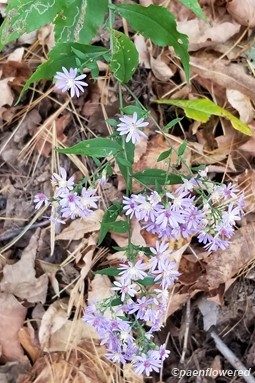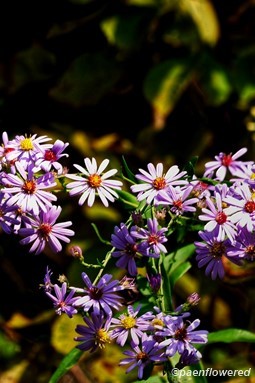Symphyotrichum laeve
Symphyotrichum laeve smooth blue aster
Add to MyPlants View Locations
Habitat & Range
Occasional in dry woods, and on rocky ledges and roadsides.
Present throughout the state with greater populations in the southeast and southcentral parts of the state.
| EMP: | FACU |
|---|---|
| NCNE: | FACU |
Phenology
Flowers from late August to October.
Characteristics
Flowers flowerheads in clusters at the top of the plant and arising from upper leaf axils; branches stiff and usually ascending. From 15 to 30 blue to purplish (ocassionally white) rays, yellow center disc urn reddish with age.; l Bracts around the base of the flower are 4 to 6 layers, narrow, appressed to slightly spreading, light green; lance to diamond-shaped tip with a few tiny hairs around the edge. Pedicels are up to 2.5 in long, mostly glabrous with a few leaf-like bracts below the flower.
Leaves up to 4 in. long and 1.5 in. wide, smooth, either without teeth or with a few shallow teeth, mostly galbrous and tend to clasp the stem. Basal leaves vary in shape, from spatula-like to lance-oblong and have winged, sheathing stalks. As in most asters basal and lower stem leaves tend to wither away by flowering time, occasionally may persist. As leaves go up the stem they become smaller, nearly erect, more lance-linear and rounded at the base or may clasp the stem with small lobes.
Stems single or multiple from the base, erect, glabrous or with some hairs in the upper plant, green or reddish.
Fruit a dry seed with a tuft of light brown hair. Seeds are 2 to 4 mm long, brown to deep purple, oblong and broadest near the tip, somewhat flattened with 4 or 5 longitudinal ridges. Seeds get carried off by the wind.
Plant Codes
S-rank: No rank
G-rank: G5 (Secure)
Symphyotrichum laeve smooth blue aster
Synonyms: Aster laevisAdd to MyPlants View Locations
Plant Summary
Common Names
Symphyotrichum


















Comments
Have you spotted this plant in your area? We'd love to hear about your experience! Share your comments or questions about the plant below. Comments are moderated before posting.